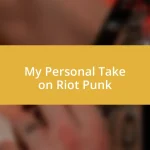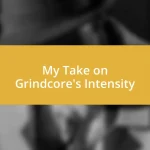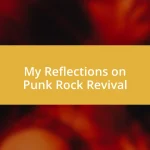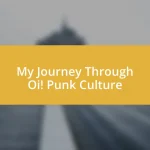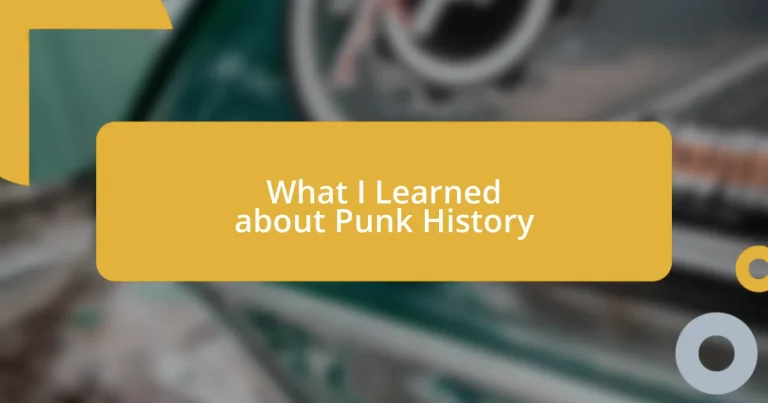Key takeaways:
- Punk rock emerged in the 1970s as a rebellion against societal norms, with bands in New York and London expressing frustrations through an aggressive sound and DIY ethos.
- Key figures like Iggy Pop, Joey Ramone, and Patti Smith shaped punk’s identity, inspiring individual voices to challenge societal expectations and push for authenticity.
- Punk has evolved into diverse subcultures and continues to influence modern social movements, encouraging creativity, activism, and a sense of community through its lasting legacy.
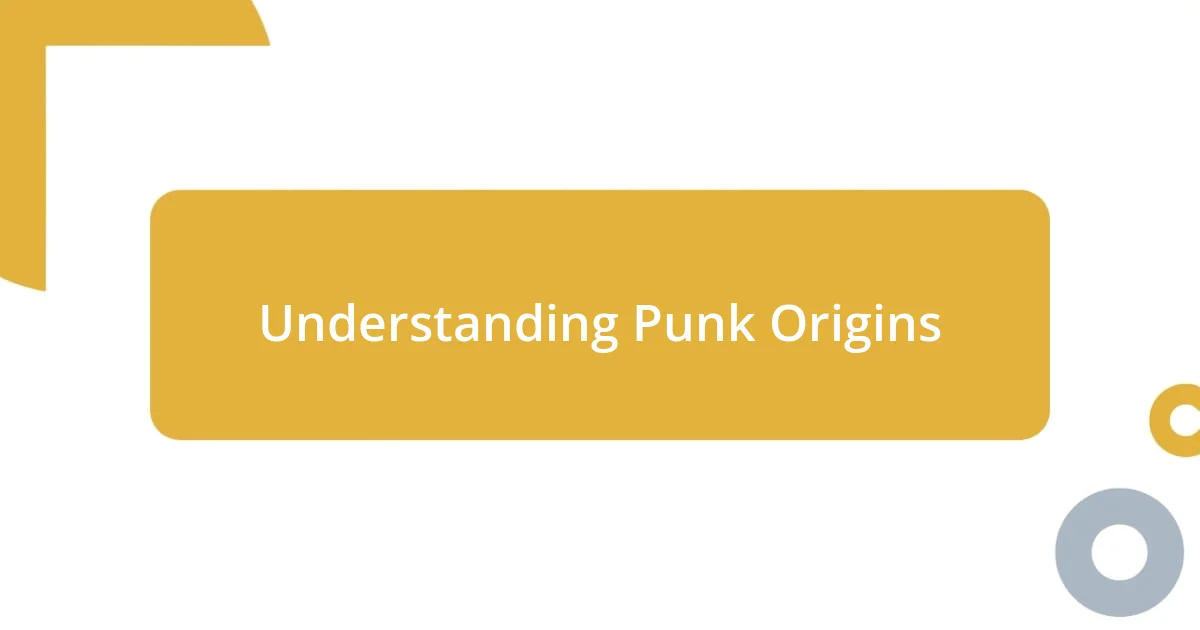
Understanding Punk Origins
The origins of punk rock can be traced back to the 1970s, a time when young people felt stifled by societal norms. I remember hearing stories from my older friends about how the music scene felt raw and revolutionary, almost like a breath of fresh air amidst the monotony of mainstream sounds. Can you imagine what it was like to experience that explosive energy firsthand?
In cities like New York and London, bands started to emerge with a sound that was unapologetically aggressive, challenging the status quo of both music and culture. It makes me think about how powerful it must have felt to attend those early shows, where the air was thick with rebellion and a sense of community. What drove those musicians to express their frustrations so loudly?
Punk was more than just music; it was an attitude that rejected conventional standards. From the fiery speeches of bands like The Ramones to the DIY ethos of The Sex Pistols, it carved out space for individual voices. I often wonder, how many of us feel the urge to break free from our own constraints? That urge is precisely what fueled the punk movement and continues to resonate today.
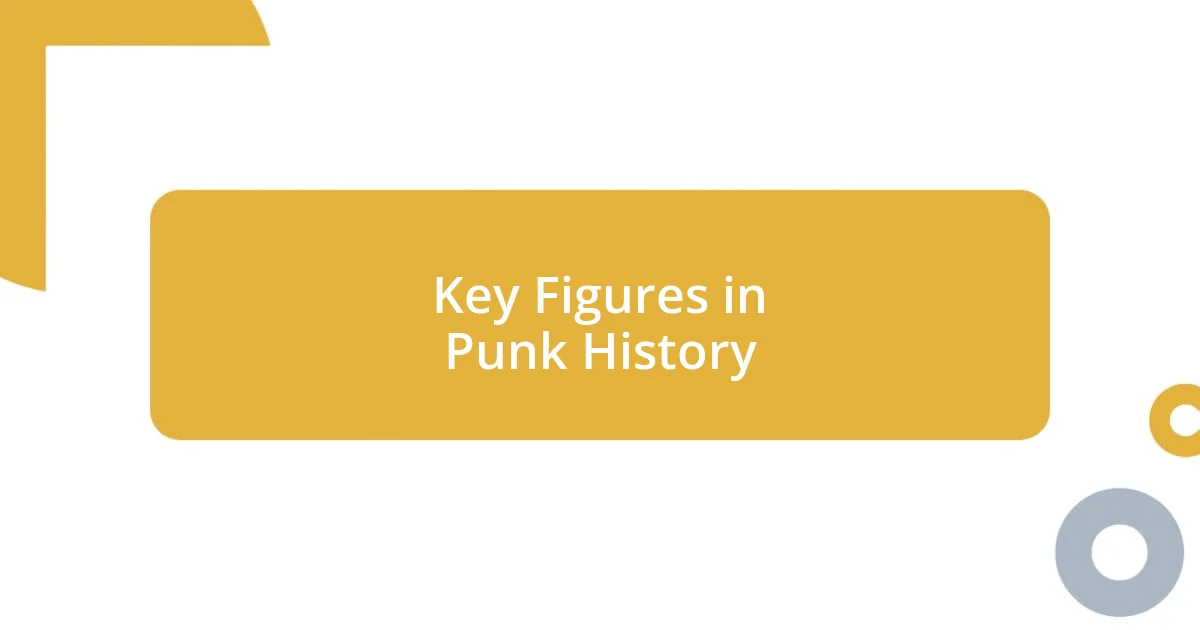
Key Figures in Punk History
When thinking about the key figures in punk history, a few names instantly come to mind, each carrying their own story of rebellion and creativity. For instance, I still vividly recall the first time I sat down to listen to Patti Smith’s “Horses.” Her blend of poetry and punk not only inspired me but also embodied the fierce spirit of the punk scene. It’s fascinating to recognize how one person’s voice can ignite a movement.
- Iggy Pop: Often referred to as the “Godfather of Punk,” his raw energy and stage presence set a benchmark for punk rock bands worldwide.
- Joey Ramone: The iconic frontman of The Ramones, he brought a unique mix of innocence and defiance to punk music.
- Johnny Rotten: As the lead singer of the Sex Pistols, his provocative persona personified punk’s rebellious ethos.
- Blondie (Debbie Harry): Pushing genre boundaries, she fused punk with pop, proving the versatility of punk rock.
- Henry Rollins: Known for his intense performances and spoken word pieces, he embodies punk’s DIY mentality and philosophical depth.
Reflecting on these figures, I realize how their individual journeys contributed to shaping a genre that would challenge societal norms and give voice to the voiceless. Each of them, in their own way, invites us to question our realities and inspires the courage to express ourselves boldly, which is perhaps the most profound lesson I’ve learned from punk history.
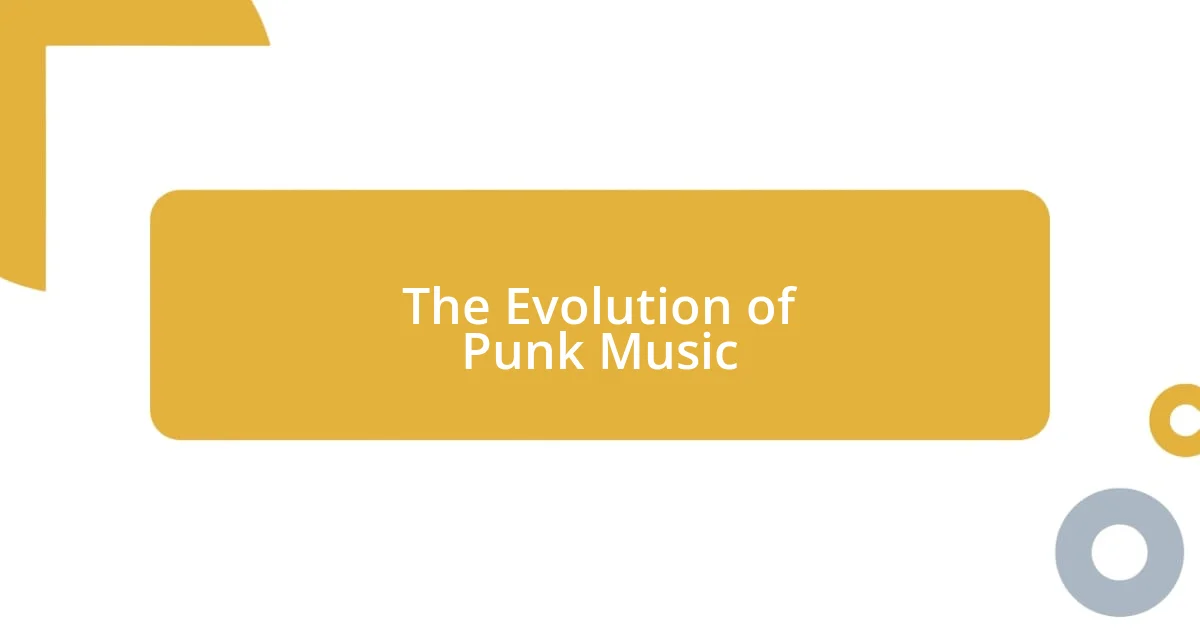
The Evolution of Punk Music
The evolution of punk music represents a dynamic journey, almost like a tapestry interwoven with rebellion and innovation. I remember the first time I was introduced to bands like The Clash and Bad Brains; it was eye-opening. These groups blended various genres, creating powerful sounds that captured the angst and excitement of their times. It’s incredible how punk adopted influences from reggae and rockabilly while still maintaining that cutting-edge, defiant spirit.
As punk music progressed through the decades, it splintered into various subgenres. Just think of pop-punk bands like Green Day or emo-infused acts like My Chemical Romance that emerged in the ‘90s and early 2000s. I often reflect on how these shifts brought new layers to a genre that was rooted in DIY chaos. The energy transformed, but that underlying message of resistance stayed—allowing each new wave to express its own frustrations while paying homage to the original punk ethos.
I find it fascinating that punk continues to evolve, adapting to modern issues and sounds while remaining fiercely independent. The emergence of bands like IDLES and Sleater-Kinney showcases punk’s resilience and its ability to reflect today’s social and political climates. It reminds me of the importance of music as a means of expression—it’s not just about the sound; it’s about the stories, the struggles, and the unapologetic voices of today. After all, what does punk mean to us now? It feels like an invitation—an invitation to reclaim our narratives and push boundaries.
| Era | Notable Elements |
|---|---|
| 1970s | Raw sound, rebellion against mainstream, emergence of influential bands |
| 1980s | Growth of subgenres, influence of punk in pop culture, rise of bands like The Clash |
| 1990s | Pop-punk and emo, commercial success, bands like Green Day and My Chemical Romance |
| 2000s to Present | Continued evolution, blending of genres, modern punk addressing contemporary issues |
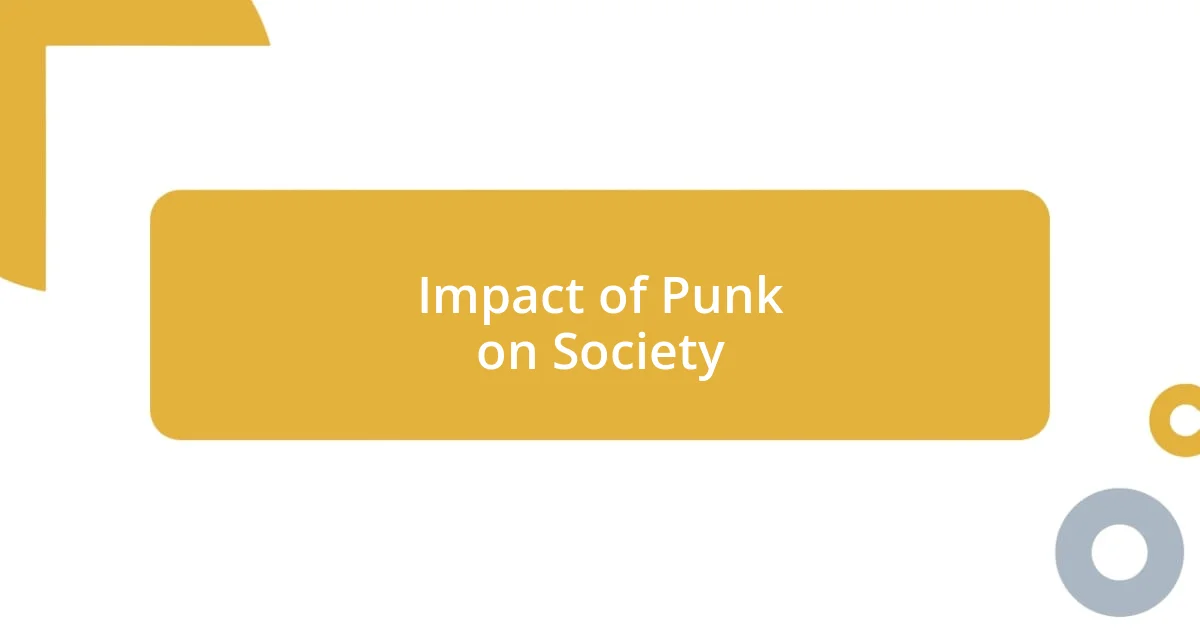
Impact of Punk on Society
Punk has had a profound impact on society, acting as a rallying cry for countless individuals. I remember attending a local punk show where the energy was electric and unapologetic. It struck me how the music brought diverse groups together, all united by a shared sense of rebellion and desire for change. That experience left me pondering: how often do we find ourselves yearning for that kind of community in our everyday lives?
Moreover, punk’s influence stretches beyond music into various aspects of culture, from art to fashion. I recall flipping through magazines filled with vibrant visuals and DIY culture, which embodied a do-it-yourself ethos that has inspired countless artists. It makes me think, what does it mean to create something from nothing? Punk teaches us that expressing ourselves authentically can challenge societal expectations and push boundaries in ways we might never have dreamed possible.
Interestingly, this movement also sparked conversations about social issues, like gender equality and mental health. Reflecting on artists like Brody Dalle from The Distillers, I see how she used her platform to address personal struggles and societal injustices. It resonates deeply with me as I often wonder how we can use our voices to advocate for change. Each punk anthem feels like an invitation, urging us to not only be part of something larger but to also question the status quo and ultimately inspire action.
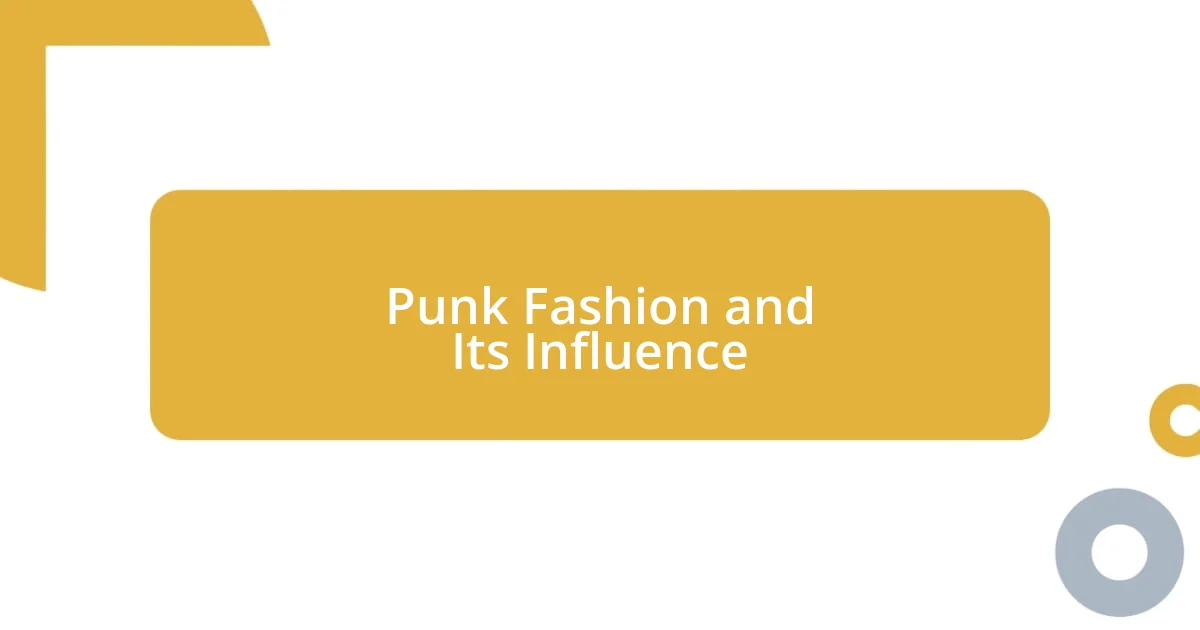
Punk Fashion and Its Influence
Punk fashion is an incredible expression of individuality, often reflecting the emotions and attitudes of the punk movement itself. I still remember flipping through iconic images of punk icons adorned with spiked hair, leather jackets, and vibrant band tees, and feeling an overwhelming sense of belonging. Just think about it: each safety pin and studded accessory tells a story of rebellion against conformity. There’s something liberating about creating a look that shouts, “I’m here, and I won’t be silenced!”
What really strikes me is how punk fashion transcended the music scene, influencing mainstream trends and even high-end fashion designers. I can vividly recall the first time I paired a vintage band tee with a plaid skirt—it was my way of owning my identity. Designers like Vivienne Westwood and Jean-Paul Gaultier not only embraced punk aesthetics but also elevated them to new heights, blending edgy styles with haute couture. Have you ever wondered how many people were inspired to break out of their shell simply through the power of attire?
Moreover, the impact of punk fashion continues to resonate today, with elements of DIY culture making their way into contemporary wardrobe choices. I often look around and see young people mixing and matching styles, creating their own interpretations of punk. It’s a reminder that the essence of punk is not just about how we dress but about championing authenticity in a world that often pressures us to conform. Isn’t that what makes punk fashion so unforgettable? It empowers us to wear our stories proudly, making every outfit a canvas for personal expression.
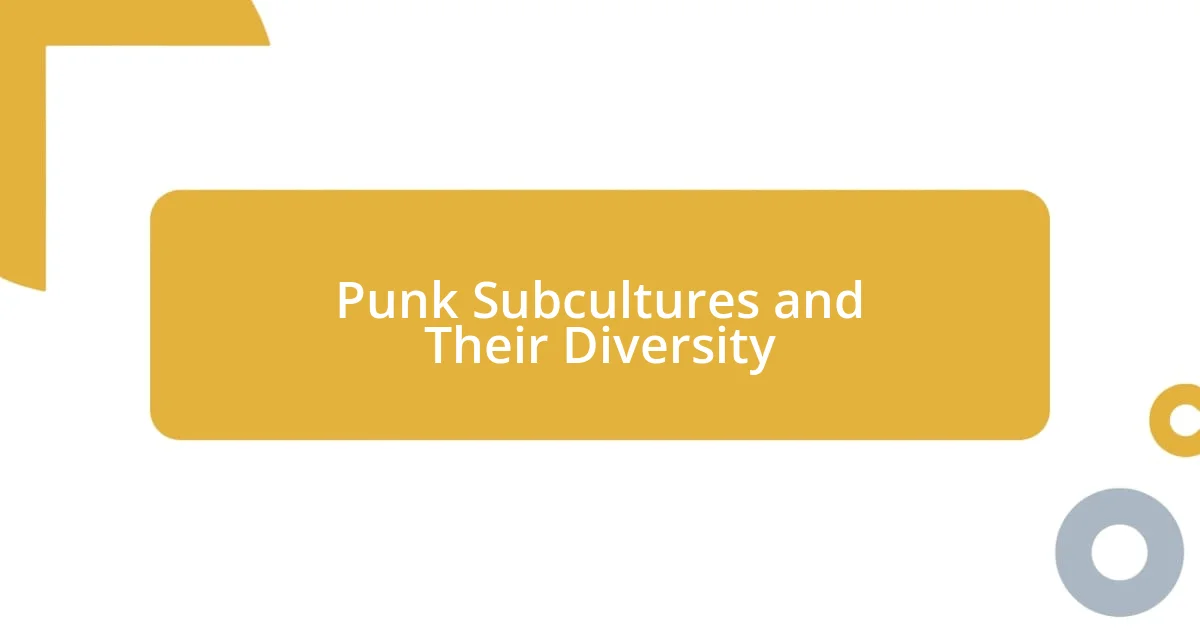
Punk Subcultures and Their Diversity
Punk subcultures are like a vivid tapestry of styles and beliefs, each thread adding to the overall picture of rebellion and self-expression. I distinctly recall the first time I ventured into a hardcore punk show; the diverse crowd was a blend of mohawks, goths, and skaters. It struck me then: how fascinating it is that, despite our varied appearances and backgrounds, we all shared a common goal—freedom of expression. This diversity is what keeps the punk movement alive, constantly evolving and challenging norms.
As I continued to explore different punk subcultures, I discovered that there’s so much more than just music; there are unique expressions of identity, like the queercore movement, which resonates deeply with those fighting for LGBTQ+ rights. I remember connecting with someone from that scene, who shared their journey of finding acceptance through punk—an experience that made me reflect on my own identity. Isn’t it incredible how music can create such safe spaces for people to connect? Hearing their story reinforced my belief that punk isn’t just about the sound but also about the solidarity we find within our diversity.
Every subculture within punk brings its own set of values and aesthetics, from the anarcho-punks who challenge political structures to the pop-punk scene that celebrates youthful angst with a catchy riff. At one point, I experimented with my style, embracing elements from various subcultures—fusing brighter colors with the classic black leather. It was empowering! This playfulness reminded me how punk truly celebrates the freedom to pick and choose elements that resonate with us personally. Who knew that a little experimentation could foster such growth and self-discovery? It’s this blend of diversity that keeps punk fresh and relevant to new generations, always inviting us to join the conversation.
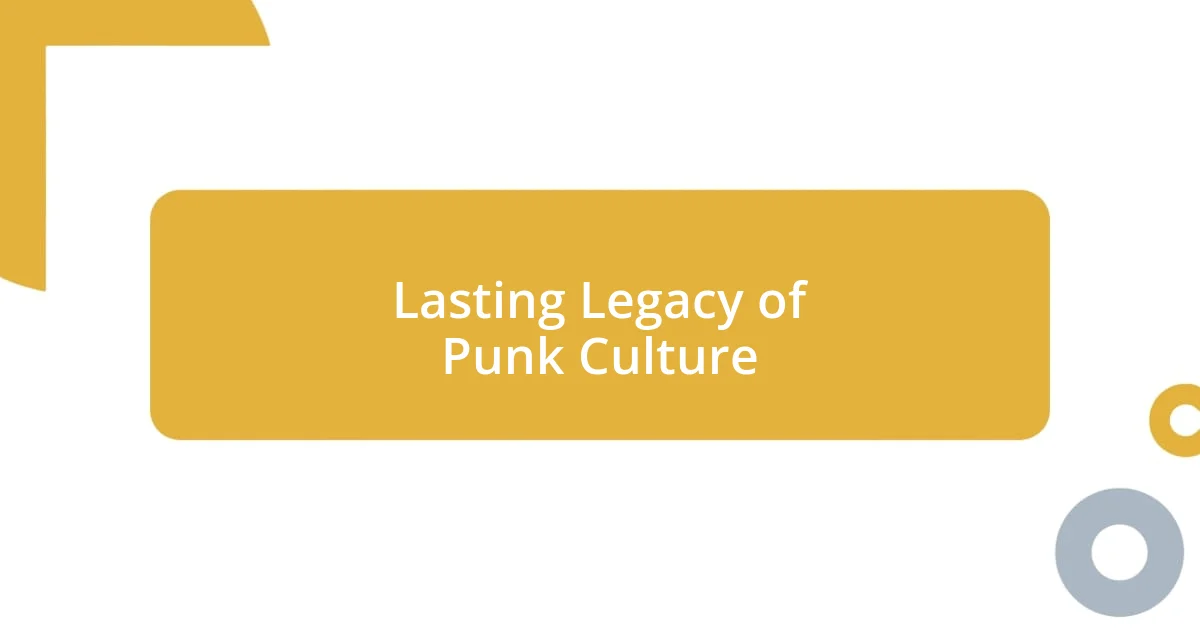
Lasting Legacy of Punk Culture
The lasting legacy of punk culture is undeniably profound, impacting not just music, but also art, politics, and social movements. I remember a time when I witnessed a local band cover classic punk anthems; the energy in the room was electric. It made me appreciate how punk has always been a vehicle for social change, giving voice to the frustrations of the marginalized. The rawness of the lyrics spoke truths that many were afraid to confront, creating a sense of community around shared experiences of struggle and resistance.
What strikes me most is how punk continues to inspire activism today. I often reflect on the recent protests where I saw young people donning punk-inspired attire, using their style as a form of protest. It’s as if they’re carrying on the torch lit by their predecessors, pushing back against injustices and raising awareness through art and fashion. Can you imagine how powerful it is to wear a patch that boldly displays your values? I’ve done it myself, and it feels like I’m part of something bigger, echoing the spirit of rebellion that punk champions.
Moreover, the do-it-yourself (DIY) ethos that punk culture promotes has paved the way for countless creators to speak their truths. I fondly recall making my own posters for a local show, pouring my heart into the design while channeling that punk spirit. It was exhilarating! This inclination to forge one’s own path encourages creativity and self-sufficiency, urging us to reclaim our narratives in a world that often tries to silence us. Punk’s legacy, then, isn’t just found in its music; it’s in this enduring drive to inspire change and assert individual identity in profoundly meaningful ways.







